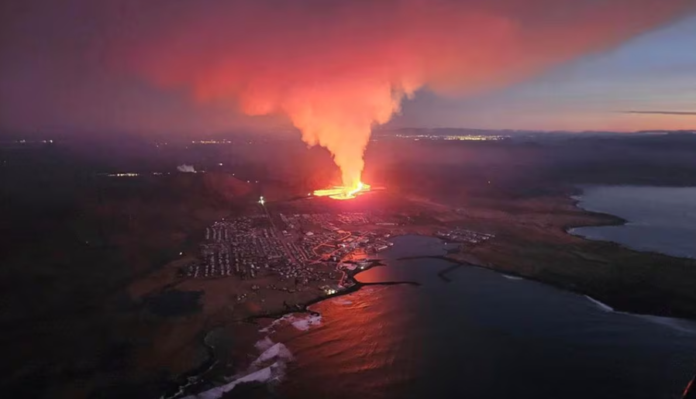A renewed volcanic eruption in Iceland is destroying homes for the first time in more than 50 years, as lava flows reached the edge of a fishing town, setting houses alight, according to Bloomberg.
At least two buildings in Grindavik were burning on Sunday afternoon, after lava-spewing fissures opened up in the ground earlier in the day, according to live footage by public broadcaster RUV. The lava vents are in the Reykjanes peninsula close to where a three-day eruption took place in December, about 40 kilometers from the country’s capital.
Though Iceland is used to eruptions, residents haven’t experienced an event threatening inhabited areas at such a scale since 1973, when part of a town of some 5,000 people was buried under lava in the Westman Islands, off the country’s south coast.
While infrastructure in Grindavik faces damage, the town was emptied on Sunday before the eruption of all inhabitants who had moved back since an earlier evacuation in November, according to Hjordis Gudmundsdottir, spokeswoman at Iceland’s Department of Civil Protection and Emergency Management. No lives are in danger, she said.
As in previous volcanic incidents recently, flights in and out of the country are operating as normal and they’re expected to continue without interruption.
“There’s no way to tell” how much destruction Grindavik might face as “that depends on the duration of the eruption,” said Benedikt Ofeigsson, a geophysicist at the Meteorological Office. While measurements point to easing activity at the site, the degree of uncertainty remains high, he said by phone.
There are two rifts currently open north of the town. One crosses a protective rampart under construction to shield the town, and one is inside the barrier.
A similar embankment was completed earlier to safeguard Iceland’s top tourist attraction, the Blue Lagoon spa, as well as HS Orka hf’s Svartsengi power plant, which provides heat to about 30,000 inhabitants of peninsula. The power plant is operating, spokeswoman Birna Larusdottir said by phone.
The area had lain dormant for almost 800 years until early 2020, when intense seismic activity started on the peninsula, with magma emerging in 2021. The current eruption is the fifth since then.
The island nation, which calls itself the land of fire and ice, has about 30 volcanic systems and more than 600 hot springs. It is one of the most geologically active places on earth due to its position between the North American and Eurasian tectonic plates on the mid-Atlantic ridge.
Fatalities from eruptions are rare. One person remains missing in Grindavik after being presumed last week to have fallen down a deep crack formed in the recent seismic activity.
One of the most disruptive volcanic events in the Nordic country’s recent history occurred in 2010, when Eyjafjallajokull erupted in an explosion that released a plume of ash so vast that it grounded air traffic across Europe for weeks, resulting in the cancellation of 100,000 flights and affecting over 10 million people.


